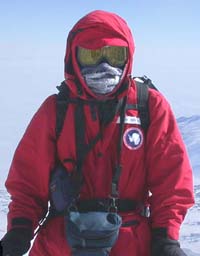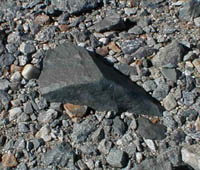|
|

|
|

|
Completely
covered as protection from the cold and winds on the summit
of Mt. Erebus. Click to Enlarge.
|

|
|
|
|

|
|
Antarctic
Feelings
|

|
Touching
the Icy Continent.
by Paul Doherty
January
7, 2002
Cold
Just
as I expected, one of the most common sensations in Antarctica
was the feeling of cold. On the summit of Mt. Erebus, I encountered
-20 C (-4 F) temperatures and 20 mph (30 kph) winds. Under
these conditions, the wind chill is so severe that when Noel
took off his face mask for just a few minutes to operate the
video camera, a white spot of frostbite appeared on his nose.
He quickly covered up his face and suffered no lasting effects.
As
I hiked up Erebus, my toes and fingers started to feel cold.
Then they began to lose feeling. I put on another warm hat,
then upped my level of exercise. As I began to rewarm my extremities,
the feeling that returned was the second Antarctic sensation:
Pain
When
warmth returns to your chilled extremities you feel an intense
burning pain. I welcomed the pain since it meant that my feet
were warming up. It also meant that my pain nerves were responding,
and so hadn't been deadened by a serious frostbite.
Hot
As
surprising as it seems, we were often hot and sweaty in Antarctica.
Whenever I flew in a helicopter, I was required to wear my
ECW (Extreme Cold Weather) gear. This gear was designed to
keep me warm in very cold and windy conditions. Having to
wear it on a warm day in McMurdo (0 C or 32 F), I rapidly
started to sweat and overheat. In the photo above on the rim
of Erebus, I am not wearing my heavy down jacket, just my
light windbreaker. I was hiking uphill and adjusted my clothing
to keep me warm without sweating. Sweat-soaked clothing is
less effective at keeping me warm. Experienced cold-weather
mountaineers are always adjusting their clothing.
Smooth
|
|

|
|

|
A
ventifact or wind carved stone one handspan long. Click
to Enlarge.
|

|
|
|
|

|
Wind-blown
sand and extremely cold snow (below -40 C or -40 F) carve
and polish rocks here, creating stones known as ventifacts.
Almost every rock I had ever seen in my life had been shaped
by water. But in the dry valleys of Antarctica, where it hasn't
rained for a million years, the rocks are shaped by the wind.
As I hiked along Andrews Ridge, a high ridge running down
the center of the Taylor Dry Valley, I spotted many fine grained
black basalt rocks polished and faceted by the wind. They
looked so unique that I took my gloves off for just a minute
to feel them, they felt as smooth as glass.
Ventifacts
often have flat faces and sharp edges, unlike river stones
which become more and more rounded with time. Flat-sided ventifacts
are classified by the number of flat faces they possess. The
stone shown on the left has three faces carved by the wind
(the bottom is not counted).
Touching
the Antarctic proved to be an interesting mix of the expected
and the unexpected. The unexpected sensations kept us awake
and alert to the world around us. We were obviously not in
San Francisco anymore.
|

